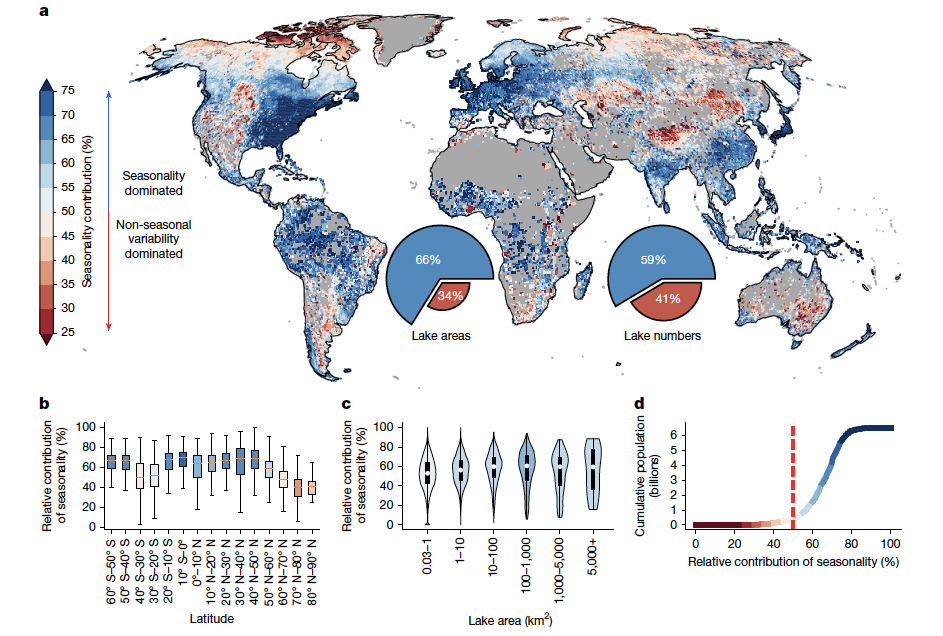Professor Di Long’s team from the Department of Hydraulic Engineering at Tsinghua University recently showcased their impactful research on the remote sensing of global surface water. The team successfully developed a deep-learning method for the spatiotemporal fusion of multi-source satellite data at a global scale, enabling continuous monthly monitoring of approximately 1.4 million lakes worldwide at a 30-meter spatial resolution. The study revealed that seasonality plays a dominant role in shaping global lake-surface-extent dynamics. Furthermore, the geographical pattern of this seasonality dominance aligns with global population distribution, indicating a strong linkage between human activities and seasonal hydrological processes in lakes.
Lakes are key components of the global hydrological cycle and ecosystems, profoundly influencing the carbon cycle, greenhouse gas emissions, and water resource availability. Lake surface extent changes over different time scales, including long-term trends, interannual variability, and seasonal changes. Although long-term trends have been extensively studied, systematic characterization of seasonal lake dynamics has been limited. Existing leading datasets, such as the Global Surface Water (GSW) dataset published in Nature by the European Commission’s Joint Research Centre in 2016, have provided a valuable foundation for global lake studies. Nonetheless, they may have some limitations in fully representing spatiotemporal continuity and capturing fine-scale seasonal dynamics.
Professor Long’s team developed a deep-learning-based spatiotemporal fusion framework to overcome these challenges. The framework integrates the advantages of MODIS’s frequent observations and GSW’s detailed spatial information. Using advanced computing resources, the team created the most comprehensive global lake surface dataset to date, featuring high spatiotemporal continuity (Fig. 1). The resulting dataset achieved high accuracy (user’s accuracy of 93% and producer’s accuracy of 96%) and notably reduced the missing data rate from 34% (in GSW) to 1.2%. This substantial improvement makes lake dynamics data more accessible and usable, facilitating stronger and more credible scientific research.

Fig. 1: Continuous and high-resolution monitoring of approximately 1.4 million global lakes achieved through deep-learning-based spatiotemporal fusion of multi-source satellite data
The study found that seasonality is the dominant factor driving lake-surface-extent dynamics in 59% of lakes that cover approximately 66% of total lake area globally (Fig. 2). Moreover, this seasonal pattern closely aligns with global population distribution—over 90% of the world’s population resides in basins where more than half of the lakes are dominated by seasonality. This finding underscores the global-scale relationship between human activities and seasonal hydrological cycles, highlighting the increasing influence of seasonality-induced extremes and human regulation. Additionally, the research reveals that seasonal extreme events can rapidly intensify or reverse long-term trends in lake surface extent, threatening the adaptability of lake ecosystems and water security. These results provide a scientific basis for more accurate estimation of lake-related greenhouse gas emissions, protecting habitats, and developing effective strategies for managing extreme hydrological events.

Fig. 2: Seasonality dominates lake-surface-extent dynamics of approximately 1.4 million lakes worldwide
These findings represent a major advancement in scientific understanding and significantly enhance the practical integration of remote-sensing big data with artificial intelligence. By overcoming the longstanding challenge of balancing spatial resolution with temporal frequency in remote sensing hydrology, this research transforms global lake monitoring from annual static observations to precise and dynamic analyses.
The study, titled “Global dominance of seasonality in shaping lake-surface-extent dynamics”, was published in Nature on May 28.
Professor Di Long from the Department of Hydraulic Engineering, Tsinghua University, is the corresponding author, with Ph.D. student Luoqi Li as the first author. Collaborators include Ph.D. student Yiming Wang from Tsinghua University and Professor R. Iestyn Woolway from Bangor University, UK. The research was supported by the National Natural Science Foundation of China and the Second Tibetan Plateau Scientific Expedition and Research program.
Link to the paper:
https://www.nature.com/articles/s41586-025-09046-3
Editor: Li Han

